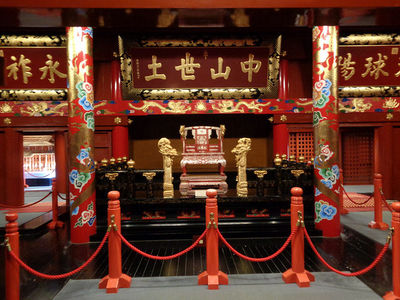Maeda Koin

- Born: 1936
- Died: 2020/1/14
- Japanese: 前田 孝允 (Maeda Kôin)
Maeda Kôin was a master of traditional Ryukyuan lacquerware. He was one of the primary artisans who reproduced the royal throne, calligraphic plaques, decorated pillars, and other lacquerware objects for the restoration of Shuri castle in the 1980s through its opening in 1992, and for display and use in reenactments at the castle in the years since then. He was designated by Okinawa prefecture as a holder of Intangible Cultural Heritage, and served as an advisor to the prefecture on traditional arts.
Originally from the Janagusuku neighborhood of Ôgimi village in northern Okinawa, Maeda attended the University of the Ryukyus, and in his fourth year was introduced by painter Adaniya Masayoshi to a part-time job at the lacquerware company Benbô, the leading producer of contemporary lacquerware designs in Okinawa at the time.[1] He graduated university in 1959 and immediately afterward was given a full-time job as a designer for the company.[2] He began showing his own work at exhibitions five years later. In 1968, he quit that job and opened his own "Maeda Lacquerware Atelier."
Maeda played a key role in the 1990 establishment of the Urasoe City Museum of Art, serving as head of the Urasoe shi kôgei bijutsukan kensetsu shingikai (Committee for the Establishment of Urasoe City Crafts Art Museum) and working with Urasoe City mayor Higa Noboru to convince a number of other government officials to support a plan for the city to purchase some 180 lacquerware objects displayed in a Ryûkyû shikki no bi ("The Beauty of Ryukyu Lacquerware") exhibit in 1983, to serve as the core of the collection for this new museum. When invited to serve as assistant director of the new museum, however, Maeda declined.[3]
In conjunction with the restoration of Shuri castle c. 1989-1992, Maeda created a red-lacquered, gilded, and painted royal throne with mother-of-pearl inlay, based on portraits of King Shô Shin and other documentary sources, a project which took about two years. He also produced many of the plaques which now hang over the castle's gates, as well as reproductions of those bestowed upon the kings of Ryûkyû by Qing emperors.
He lived in the Kinjô-chô neighborhood of Shuri during the last decades of his life, and taught as a lecturer at the Okinawa Prefectural University of the Arts and Tokyo University of the Arts. In 2005, he was named director of the Urasoe City Museum of Art, and continued to serve in that position until 2010.[1][4]
Maeda Kôin was ill and in hospital on 31 Oct 2019 when an accidental fire destroyed the Main Hall and several other buildings at Shuri castle, along with the replica thrones, plaques, and other objects created by Kôin and others. He reportedly expressed eagerness to contribute to recreating these objects again, but passed away several months later on 14 Jan 2020. His student Maeda Kunio succeeded him as head of the studio.[2]
References
- "Maeda Kôin-san shikyo Shurijô fukugen ni jinryoku Okinawa-ken shitei mukei bunkazai Ryûkyû shikki hojisha" 前田孝允さん死去 首里城復元に尽力 沖縄県指定無形文化財琉球漆器保持者, Okinawa Times, 17 Feb 2020.
- “Shitsugei Maeda Kōin-san: Shurijō ni inochi wo fukikonda shitsugei sakka” 漆芸前田孝允:首里城にいのちを吹き込んだ漆芸作家, Shuri: Ryūkyū no miyako wo aruku 首里:琉球の都をあるく, Momoto special issue 別冊モモト, Itoman: Tōyō kikaku (2013/8), 24-29.
- "Ryûkyû shikki" 琉球漆器, Fee nu kaji 南ぬ風 3 (2007/4-6), 3-5.
- ↑ 1.0 1.1 "Shurijô Seiden ha sekai saidaikyû no urushi no ki. Shurijô no shûfuku, fukugen ga dekiru shokunin o sodatete moraitai"「首里城正殿は世界最大級の漆の器。首里城の修復、復元ができる職人を育ててもらいたい。」、Fee nu kaji 南ぬ風 9 (2008/10-12), 3.; Kinjô Satoko 金城聡子, et al, "Maeda Kôin shi o itamu" 「前田孝允氏を悼む」, Shurijô kenkyû 首里城研究 23 (March 2021), 96.
- ↑ 2.0 2.1 Kinjô, 96.
- ↑ Asato Susumu 安里進, et al, "Maeda Kôin shi o itamu" 「前田孝允氏を悼む」, Shurijô kenkyû 首里城研究 23 (March 2021), 95.
- ↑ Kinjô, 97.